Children Walking and Biking: Mapping Houston’s Injury Hotspots

Table of Contents
Author(s)
Zoabe Hafeez
Nonresident FellowShruti Natarajan
B.S.; Medical Student, McGovern Medical School at UTHealth in HoustonShare this Publication
- Print This Publication
- Cite This Publication Copy Citation
Zoabe Hafeez and Shruti Natarajan, “Children Walking and Biking: Mapping Houston’s Injury Hotspots” (Houston: Rice University’s Baker Institute for Public Policy, March 5, 2024), https://doi.org/10.25613/KV7Z-P827.
Benefits of Physical Activity for Children
Over the last 50 years, children in the United States have become considerably less active.[1] In 1969, close to 50% of young people walked or biked to school; five decades later this figure is just over 10% (Figure 1). This marked decrease in children’s physical activity is of great concern and may have effects on their physical health, social health, well-being, and autonomy.[2]
In a similar vein, developmental psychologist Peter Gray argues that unstructured play serves a vital role in fostering children's resilience, self-agency, and belief in the ability to control their own lives. It also appears to increase social success, along with improved psychological and physical health later in life.[3] With fewer opportunities for outdoor play, children’s physical activity is reduced.
Figure 1 — Change in Active Transportation to School Over Time[4]
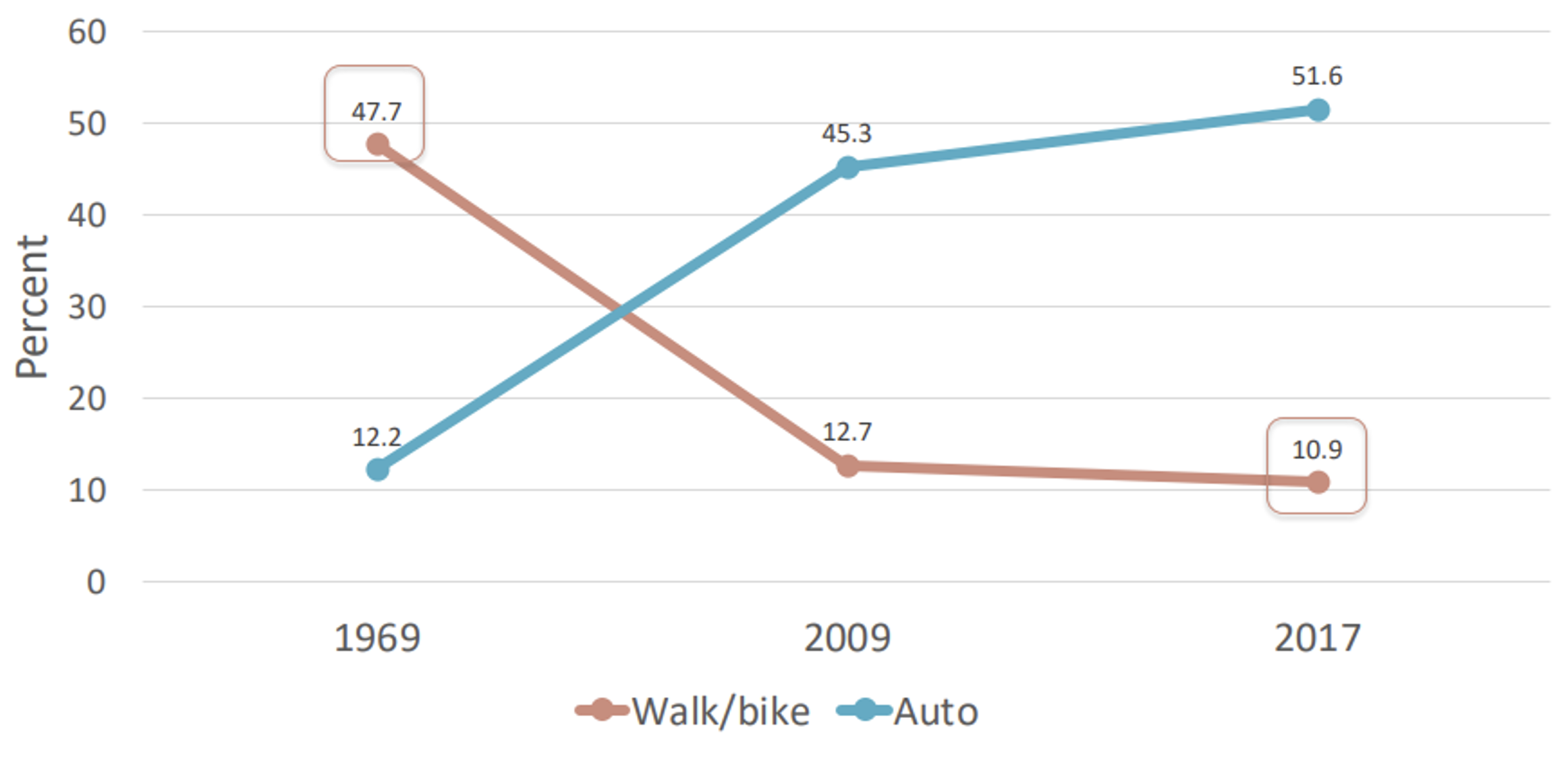
Note: The term “active transportation” includes cyclists, pedestrians, and other non-car transport.
The American Academy of Pediatrics’ declaration of a child and adolescent mental health crisis, and an alarming increase in childhood obesity, highlight the need to intervene — increasing physical activity in children can decrease sedentarism and improve their physical and mental health.[5] Walking benefits mental health and — in the face of a dual loneliness and obesity epidemic — getting children out of cars can have benefits on multiple fronts.[6] However, only if it doesn’t contribute to a third trend: The United States is one of the few first world countries seeing an increase in pedestrian mortality over time.[7]
Houston’s High Injury Network Map
In the Houston area, one of the biggest limiting factors to children using active transportation is the risk of motor vehicle injury, but work is already under way to improve their safety.[8]
- The city of Houston developed a high injury network map identifying streets that have a disproportionate number of active transportation injuries in all age groups and has begun work on structural improvements — part of a larger plan that was intended to end transportation deaths and serious injuries by 2030.[9]
- The Department of Transportation awarded Houston a $10.1 million grant to undertake four projects from the network map to further these efforts.[10]
This brief will investigate hot spots of pediatric active transportation injuries in Houston. It will identify places where interventions offer the greatest opportunity for improvement and recommend ways to increase active transportation in young people while also reducing injuries.
Child Injury Hotspots
In our study, we analyzed all active transportation injuries and fatalities to children in Houston from 2018–23.[11] In all, 629 incidents were recorded, of which 21 were fatal and 159 were serious. Of these, 454 incidents had geospatial data allowing us to create the map below (Figure 2).
Within the mapped data, we were able to identify three broad hotspots. Two were in southwest Houston, along the Interstate 59 and Westpark Tollway corridors, and the third was in south Houston’s Sunnyside neighborhood. Within these clusters, four smaller areas stood out as particularly dangerous for children.
- Alief: Beechnut Street near Wilcrest Drive.
- Gulfton: Glenmont Drive from Renwick Drive to Royalton Street.
- Sunnyside: The Sunnyside Square Mile.
- Gulfton: Hillcroft Avenue.
In the next sections we will examine each area in turn and, in a case study of Gulfton’s Hillcroft Avenue, outline the benefits of improving hot spots.
Figure 2 — Map of Incidents[12]
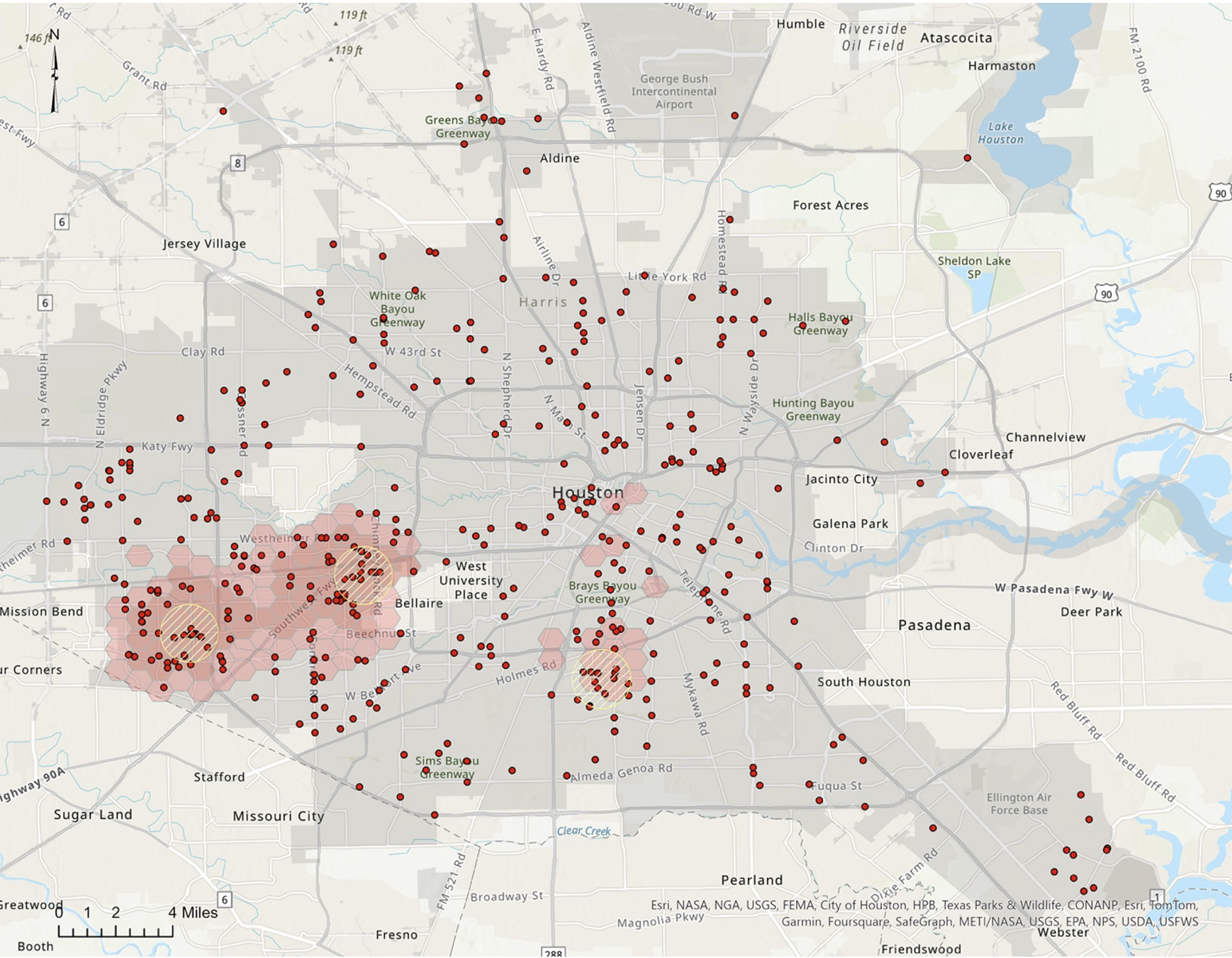
Notes: Red dots indicate mappable incidents; red background indicates top 20% Getis-Ord Gi* Z-Score; deep red indicates top 10%; and gray indicates city limits. Areas highlighted by yellow circles correspond to (from left to right) the Beechnut Street, Glenmont Drive, and Sunnyside Mile hotspots explored below. The Hillcroft Avenue hotspot is immediately west of the Glenmont Drive hotspot and is not highlighted.
Alief: Beechnut Street near Wilcrest Drive
Figure 3 — Beechnut Looking West at Wilcrest
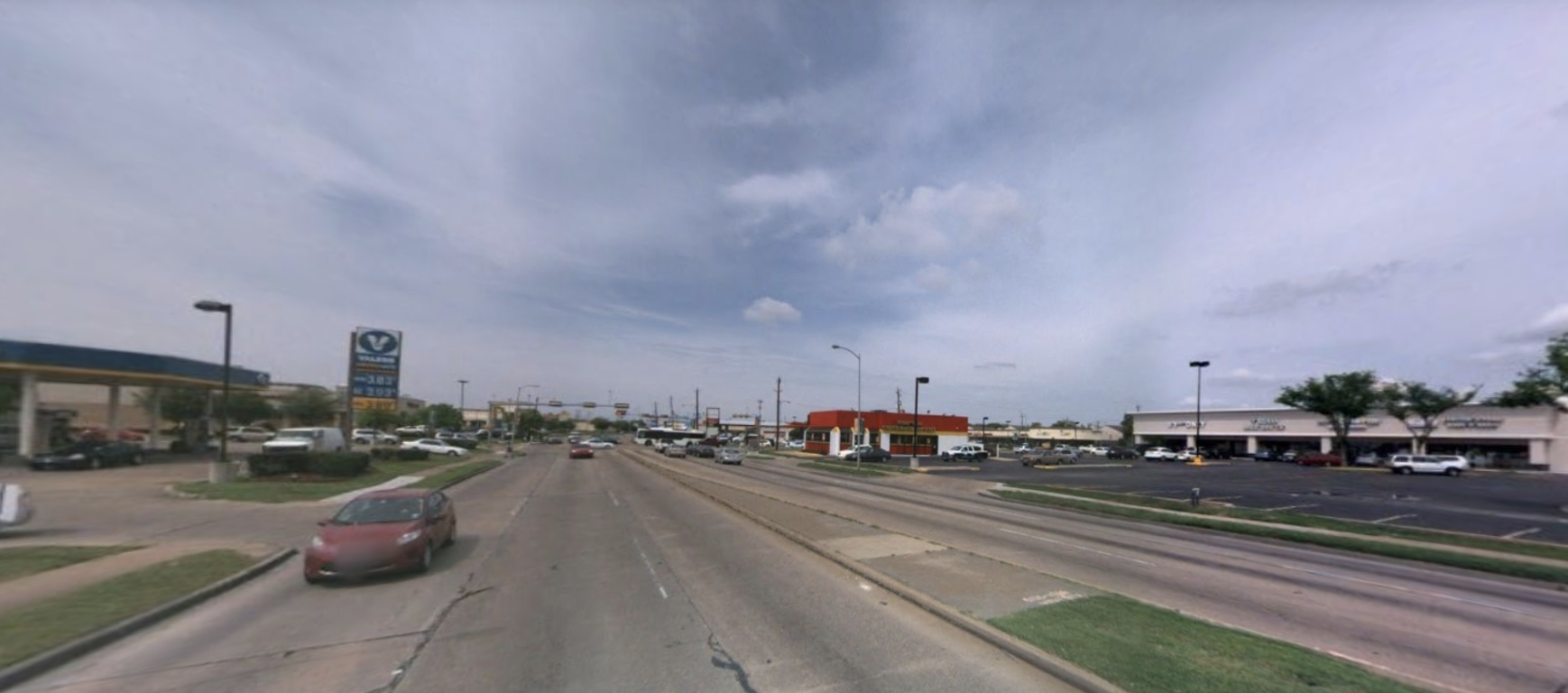
Note: Approximate site of two fatal child pedestrian injuries in 2023 (Beechnut looking west at Wilcrest).
The intersection of Beechnut and Wilcrest in the Alief neighborhood is a bustling commercial hub, anchored by four strip malls that reflect the area's cultural diversity (Figure 3). Businesses include an African goods store, two Viet-Cajun restaurants, and a beauty college. The intersection is typical of those in the neighborhood, but the approach is complicated by over 30 unsignalized driveways that open into streets adjacent to the intersection. The intersection itself is five to seven lanes wide at each crossing.
Figure 4 — Beechnut Area Incidents
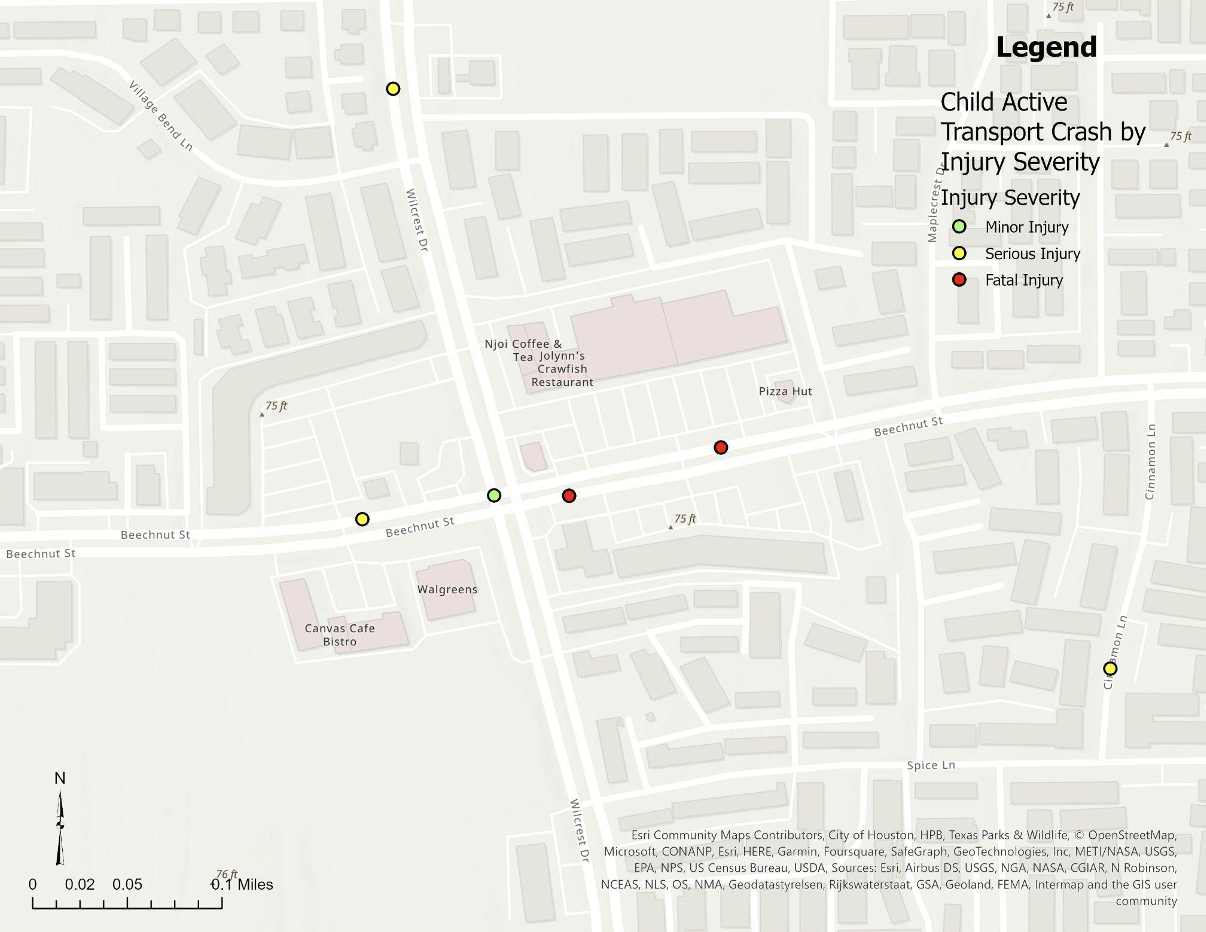
Tragically, this intersection witnessed the fatalities of two children in 2023 — a 13-year-old boy and a 15-year-old girl. Two other serious injuries also occurred in this area. One of these incidents happened within the intersection, while others took place adjacent to the intersection along Beechnut (Figure 4).
Gulfton: Glenmont Drive from Renwick Drive to Royalton Street
Gulfton is a dense, predominantly Hispanic and Spanish-speaking neighborhood in southwest Houston.[13] Glenmont Drive, a fast moving collector street, had four child active transportation injuries during the period under study — including that of a one-year-old who, thankfully, survived with minor injuries (Figure 5). Glenmont is a medium speed street with two lanes each way and limited commercial driveways entering the street (Figure 6). Three of the four injuries occurred at a midblock crossing. As shown in Figure 7, this is common in the city, with over 60% of the injury generating crashes occurring between intersections.
Figure 5 — Glenmont Area Incidents
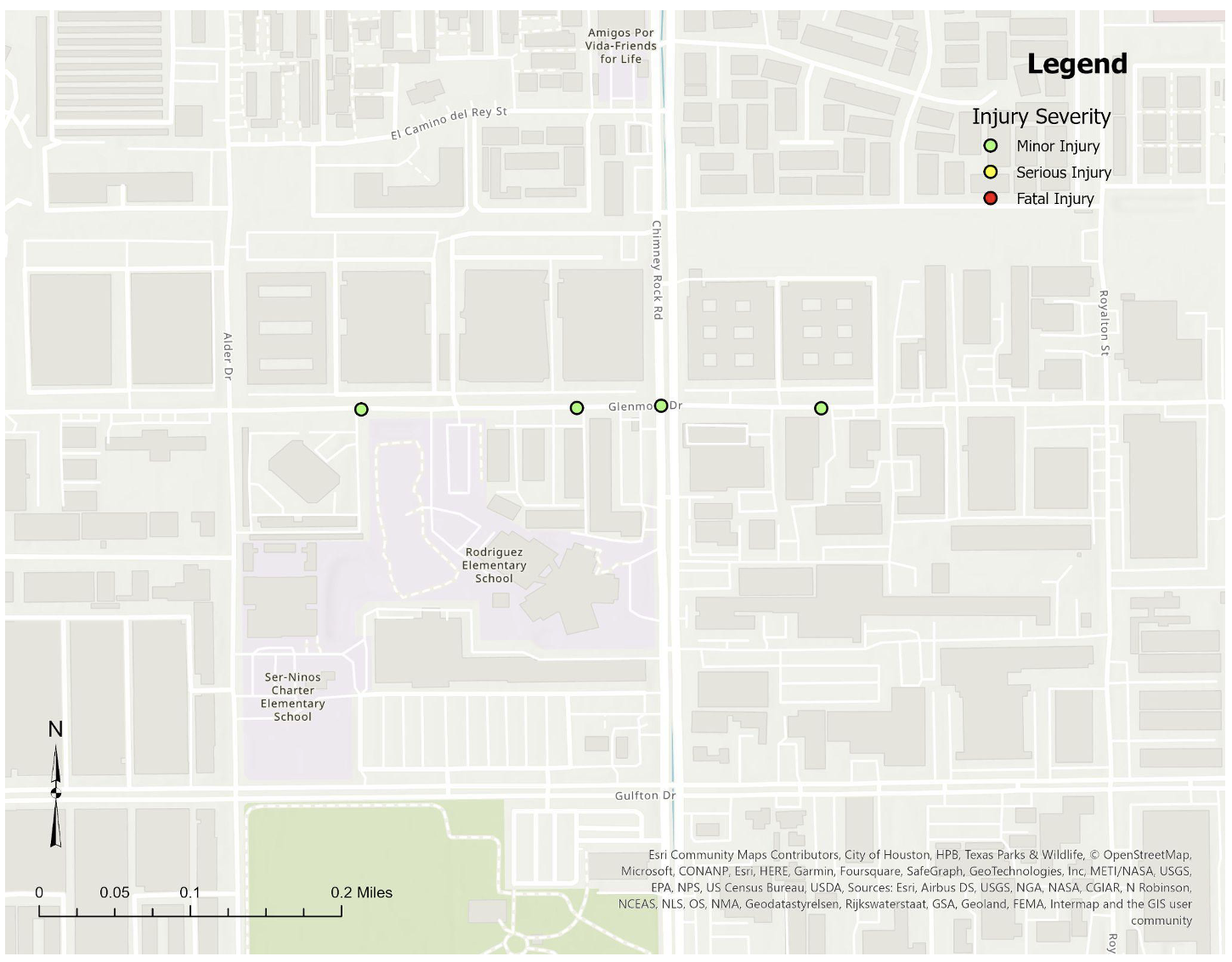
Figure 6 — Glenmont Drive Looking West Toward Chimney Rock
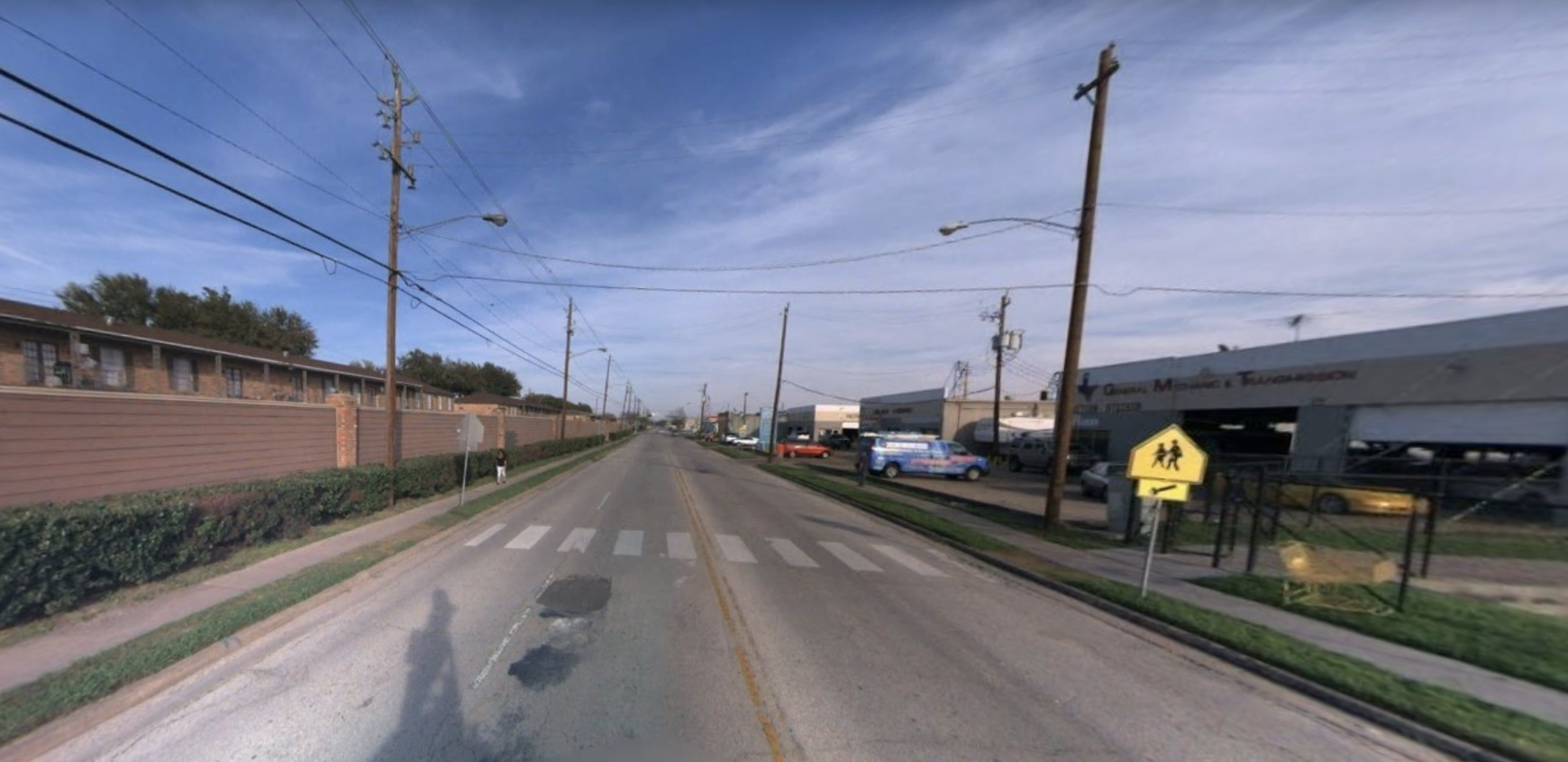
Figure 7 — Percentage of Crashes by Intersection Category
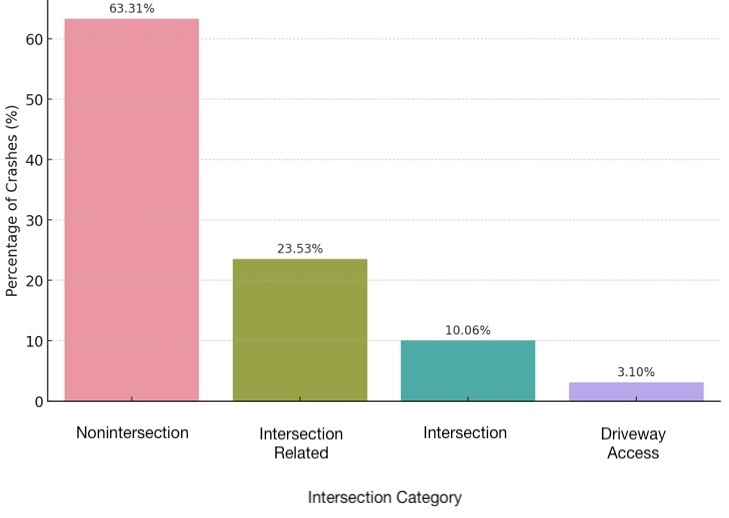
Sunnyside: The Sunnyside Square Mile
Figure 8 — Sunnyside Area Incidents
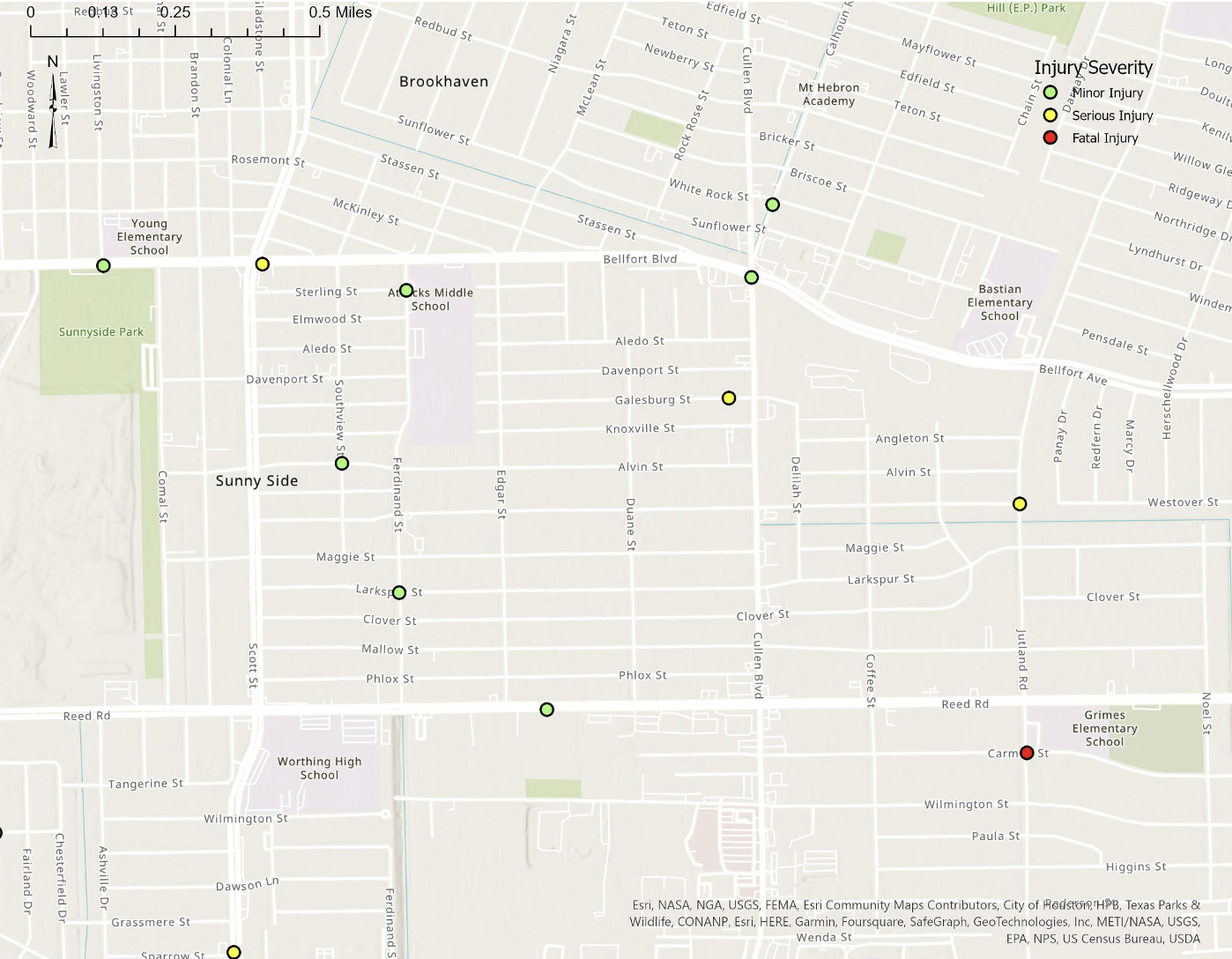
Finally, there is a cluster in the Sunnyside neighborhood of southside Houston, a majority Black neighborhood. This area, approximately one square mile in size — and with four schools — had 12 incidents (Figure 8). Seven involved pre-teen children, including a 1-year-old and a 3-year-old, the latter of whom sustained serious injuries. One incident was fatal: A 14-year-old boy was killed close to Grimes Elementary School in April 2021.
This cluster is unique in that injuries occurred on a variety of road types including the complex intersection of Bellfort and Cullen, midblock crossings of fast-moving roads, and slow-moving neighborhood streets. Nevertheless, two themes emerge:
- All but two of the incidents occurred on uncontrolled intersections or were attempted midblock crossings. This is unsurprising as the entire square mile has only five traffic lights controlling it.
- This cluster may at least partially result from behaviors that are more conducive to injuries. TxDOT’s Crash Record Information System reports that the rate of severe transportation injuries in the Black population of Harris County were 196 per 100,000 residents in 2023 compared to 135 in the general population. Explanations for this phenomenon, which has been observed nationally, are wide ranging and include systemic infrastructure underinvestment in historically marginalized communities, disparities in medical access and response, and risky driving behavior such as intoxicated driving.[14] To the last point, liquor stores are disproportionately concentrated in communities of color in a number of settings.[15]
Benefits of Hot Spot Improvement: Gulfton’s Hillcroft Case Study
A stretch of Hillcroft Avenue — identified by both Houston’s “Mayor Safe Street Initiative” and our study as an injury hotspot — was redesigned in 2021 with safety of all users in mind.[16] Safety improvements included wider sidewalks, shared-use bikeways, improved intersections for pedestrian access, improved bus stop access, and the reduction of motor vehicle lanes from eight to six (Figure 9).
As a result, motor vehicle speeds were reduced by 5–10 miles per hour in two major intersections where drivers encounter active transportation users frequently. Additionally, pedestrians and bicyclists were less likely to encounter motor vehicles in an unsignalized intersection and were able to travel at higher speeds, enhancing overall safety and efficiency of movement in these areas.[17]
Figure 9 — Hillcroft/Dashwood Before and After
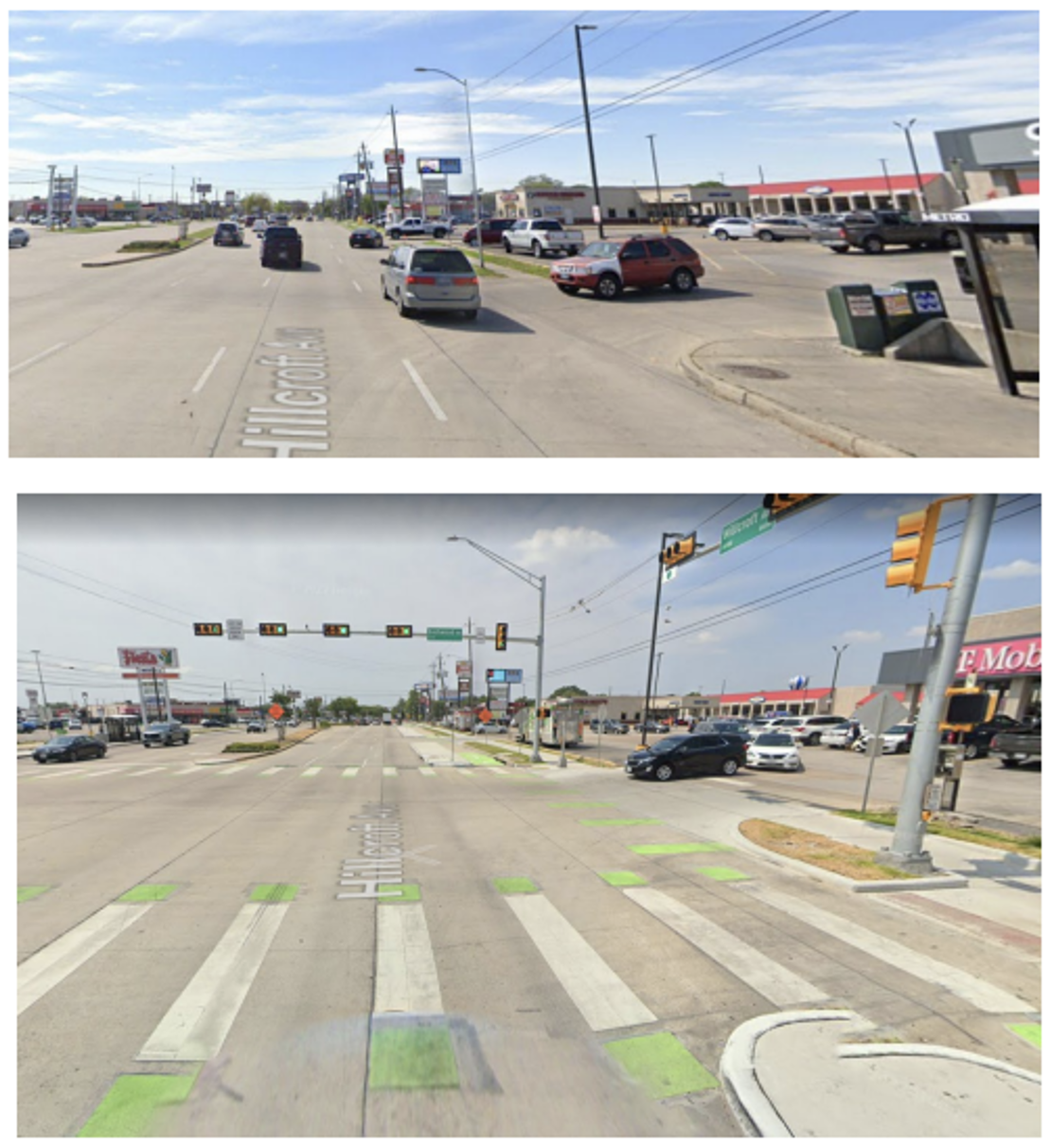
Note: Conditions at Hillcroft/Dashwood intersection before (above) and after (below).
Recommendations
While in this brief we have studied clusters in southwest Houston and cluster Sunnyside, the areas of Houston where children were injured by motor vehicle drivers over the last five years are as diverse as the city itself. Unfortunately, this means that the solutions cannot be “one size fits all.” However, three broad recommendations may guide the way:
- Focus on the worst areas first. Creating a high injury network map focused on children could give stakeholders the tools to identify areas that offer the highest benefit at the lowest cost.
- Improve sidewalks and crosswalks. Most young people’s active transportation is on foot or via bicycle. This means that widening sidewalks into shared-use pathways, minimizing unsignalized conflict points, and creating pedestrian friendly intersections can have outsized benefits.
- Work on behaviors. In areas where the problem is not limited to one specific road type, behavioral interventions may be beneficial. This can include:
— Working with law enforcement to identify high risk driving behaviors and impaired drivers.
— Collaborating with schools to provide education on safe pedestrian and bicycling behaviors.
— Implementing a “walking school bus,” where groups of children walk to school together under parental supervision. This type of intervention has been successful in parts of the Houston area.[18]
Interventions to reduce injury and fatality to children in active transportation incidents can serve the dual purpose of improving child health and creating more economically strong communities. Building attractive, walkable communities where children can flourish also increases commercial and residential property values, decreases the need for parking lots, and reduces public expenditure.[19]
Taken together, identifying and intervening against child active transportation injury hot spots can have outsized benefits across a variety of domains.
Notes
[1] Eleftheria Kontou et al., “U.S. Active School Travel in 2017: Prevalence and Correlates,” Preventive Medicine Reports 17, art. 101024 (March 2020), https://doi.org/10.1016/j.pmedr.2019.101024; Mary K. Wolfe and Noreen C. McDonald, “Association Between Neighborhood Social Environment and Children’s Independent Mobility,” Journal of Physical Activity and Health 13, no. 9 (2016): 970–9, https://doi.org/10.1123/jpah.2015-0662; and Noreen C. McDonald et al., “U.S. School Travel, 2009: An Assessment of Trends,” American Journal of Preventive Medicine 41, no. 2 (August 2011): 146–51, https://doi.org/10.1016/j.amepre.2011.04.006.
[2] Kontou, “U.S. Active School Travel in 2017”; Paul Kelly et al., “Walking on Sunshine: Scoping Review of the Evidence for Walking and Mental Health,” British Journal of Sports Medicine 52, no. 12 (2018): 800–6, https://doi.org/10.1136/bjsports-2018-100289; Julianne Stark et al., “Active School Travel, Attitudes and Psychological Well-Being of Children,” Transportation Research Part F: Traffic Psychology and Behaviour 56 (July 2018): 453–65, https://doi.org/10.1016/j.trf.2018.05.007; and Peter Gray, David F. Lancy, and David F. Bjorklund, “Decline in Independent Activity as a Cause of Decline in Children’s Mental Well-being: Summary of the Evidence,” Journal of Pediatrics 260, art. 113352 (September 2023), https://doi.org/10.1016/j.jpeds.2023.02.004.
[3] Gray, Lancy, and Bjorklund, “Decline in Independent Activity”; Werner Greve and Tamara Thomsen, “Evolutionary Advantages of Free Play During Childhood,” Evolutionary Psychology 14, no. 4, art, 1474704916675349 (2016), https://doi.org/10.1177/1474704916675349; and Julia Schønning Vigdal and Kolbjørn Kallesten Brønnick, “A Systematic Review of ‘Helicopter Parenting’ and Its Relationship With Anxiety and Depression,” Frontiers in Psychology 13, art. 872981 (May 2022), https://doi.org/10.3389/fpsyg.2022.872981.
[4] The term “active transportation” includes cyclists, pedestrians, and other non-car transport: “Statewide Active Transportation Plan,” Texas Department of Transportation, n.d., https://www.txdot.gov/projects/projects-studies/statewide/statewide-active-transportation-plan.html; Leigh Ann Ganzar and Coleen Gentles, Hitting the STREETS: Evaluating Health Effects of Municipally Funded Safe Routes to School Infrastructure Projects in Austin, Texas, UTHealth School of Public Health, April 11, 2022, https://sph.uth.edu/research/centers/dell/resources/streets_papren_4-11-2022.pdf.
[5] “AAP-AACAP-CHA Declaration of a National Emergency in Child and Adolescent Mental Health,” American Academy of Pediatrics, October 19, 2021, https://www.aap.org/en/advocacy/child-and-adolescent-healthy-mental-development/aap-aacap-cha-declaration-of-a-national-emergency-in-child-and-adolescent-mental-health/; Eric M. Bomberg, Theodore Kyle, and Fatima C. Stanford, “Considering Pediatric Obesity as a US Public Health Emergency,” Pediatrics 152, no. 4 (September 2023): e2023061501, https://doi.org/10.1542/peds.2023-061501.
[6] Kelly et al., “Walking on Sunshine”; Bomberg, Kyle, and Stanford, “Pediatric Obesity as a US Public Health Emergency.”
[7] “Dangerous By Design 2022,” Smart Growth America, accessed March 1, 2024, https://smartgrowthamerica.org/dangerous-by-design/; Emily Badger and Alicia Parlapiano, “The Exceptionally American Problem of Rising Roadway Deaths,” New York Times, November 27, 2022, https://www.nytimes.com/2022/11/27/upshot/road-deaths-pedestrians-cyclists.html.
[8] Dug Begley and St. John Barned-Smith, “Out of Control: Houston’s Roads, Drivers Are Nation’s Most Deadly,” Houston Chronicle, January 21, 2019, https://www.houstonchronicle.com/news/investigations/article/Houston-s-roads-drivers-are-nation-s-most-12865072.php.
[9] City of Houston, Vision Zero Annual Report 2022 (2023), https://www.houstontx.gov/visionzero/Vision-Zero-Annual-Report-2022.pdf.
[10] “Federal Update: Bipartisan Infrastructure Law,” City of Houston, accessed March 1, 2024, https://www.houstontx.gov/federal-update/ssr4a.html.
[11] As reported by the Texas Department of Transportation’s Crash Records Information System (CRIS). Data pulled on December 31, 2023.
[12] To learn about this statistic and how hot spots are analyzed, see “How Hot Spot Analysis (Getis-Ord Gi*) Works,” ArcGIS Pro, n.d., https://pro.arcgis.com/en/pro-app/3.1/tool-reference/spatial-statistics/h-how-hot-spot-analysis-getis-ord-gi-spatial-stati.htm.
[13] Kyle Shelton, “Sure, Houston Has Sprawl. But Some Areas Have East Coast Levels of Density” (Houston: Rice University’s Kinder Institute for Urban Research, April 17, 2017), https://kinder.rice.edu/urbanedge/sure-houston-has-sprawl-some-areas-have-east-coast-levels-density; City of Houston Planning and Development Department, Gulfton Super Neighborhood Resource Assessment (April 2021), https://www.houstontx.gov/planning/Demographics/2019%20Council%20District%20Profiles/Gulfton_Final.pdf.
[14] Matthew A. Raifman and Ernani F. Choma, “Disparities in Activity and Traffic Fatalities by Race/Ethnicity,” American Journal of Preventive Medicine 63, no. 2 (August 2022): 160–7, https://doi.org/10.1016/j.amepre.2022.03.012; Aaron Chalfin and Maxim N. Massenkoff, “A New Racial Disparity in Traffic Fatalities,” National Bureau of Economic Research, Working Paper 30636 (November 2022), https://doi.org/10.3386/w30636.
[15] “Off-Premises Liquor Stores Targeted to Poor Urban Blacks,” Johns Hopkins School of Public Health, June 6, 2000, https://publichealth.jhu.edu/2000/alcohol-off-premises; Jennifer Scott et al., “Structural racism in the built environment: Segregation and the overconcentration of alcohol outlets,” Health & Place 64, art. 102385 (July 2020), https://doi.org/10.1016/j.healthplace.2020.102385; Mike Dolan Fliss et al., “Measuring and Mapping Alcohol Outlet Environment Density, Clusters, and Racial and Ethnic Disparities in Durham, North Carolina, 2017,” Preventing Chronic Disease 18, art. 210127 (September 2021), http://dx.doi.org/10.5888/pcd18.210127.
[16] “New Vision for Hillcroft Ave. Safety Taking Shape,” Southwest Management District, May 4, 2021, https://southwestmanagementdistrict.org/2021/05/04/new-vision-for-hillcroft-ave-safety-taking-shape/.
[17] DKS Associates, Transoft Solutions, and Together for Safer Roads, Hillcroft Avenue Before/After Study Using Video-Based Conflict Analytics, December 2022, https://www.togetherforsaferroads.org/wp-content/uploads/2023/03/221221-Hillcroft-Video-Analytics-Technical-Memo_v2.pdf.
[18] Jason A. Mendoza et al., “The Walking School Bus and Children's Physical Activity: A Pilot Cluster Randomized Controlled Trial,” Pediatrics 128, no. 3, (September 2011): e537–44, https://doi.org/10.1542/peds.2010-3486.
[19] Mi Diao and Joseph Ferreira, Jr., “Residential Property Values and the Built Environment: Empirical Study in the Boston, Massachusetts, Metropolitan Area,” Transportation Research Record: Journal of the Transportation Research Board 2174, no. 1 (January 2010): 138–47, https://doi.org/10.3141/2174-18; Robert Cervero and Michael Duncan, “Neighbourhood Composition and Residential Land Prices: Does Exclusion Raise or Lower Values?” Urban Studies 41, no. 2 (February 2004): 299–315, https://doi.org/10.1080/0042098032000165262; Charles C. Tu and Mark Eppli, “Valuing the New Urbanism: The Case of Kentlands,” Real Estate Economics 27, no. 3 (September 2003): 425–51, https://doi.org/10.1111/1540-6229.00779; Dong Wook Sohn, Anne Vernez Moudon, and Jeasun Lee, “The Economic Value of Walkable Neighborhoods,” Urban Design International 17, no. 2 (June 2012): 115–28 (2012), https://doi.org/10.1057/udi.2012.1; Gary Pivo and Jeffrey D. Fisher, “The Walkability Premium in Commercial Real Estate Investments,” Real Estate Economics 39, no. 2 (March 2011); 185–219, https://doi.org/10.1111/j.1540-6229.2010.00296.x; New York City Department of Transportation, Measuring the Street: New Metrics for 21st Century Streets (2012), https://www.nyc.gov/html/dot/downloads/pdf/2012-10-measuring-the-street.pdf; and Reid Ewing et al., Growing Cooler: The Evidence on Urban Development and Climate Change, (Washington, D.C.: Urban Land Institute, 2007), https://knowledge.uli.org/-/media/files/research-reports/2008/growingcooler.pdf?rev=7c96cfaef0e94f4ca1642268e74ff9cf.
This material may be quoted or reproduced without prior permission, provided appropriate credit is given to the author and Rice University’s Baker Institute for Public Policy. The views expressed herein are those of the individual author(s), and do not necessarily represent the views of Rice University’s Baker Institute for Public Policy.


